Dentsu Inc. Cashless Project (*) conducted its second "Cashless Awareness Survey" ( survey overview here ). The purpose of this survey was to clarify how consumers' payment methods are changing amid significant lifestyle shifts due to the novel coronavirus, and which payment methods will become mainstream going forward. This series will use the survey results to unravel the current state of cashless user growth in Japan and the barriers still hindering its advancement.
※ = Dentsu Inc. Cashless Project
A project team providing marketing strategy support in the payment domain, centered on cashless solutions
This installment covers the slow progress of cashless adoption among small and medium-sized enterprises (SMEs) and the reasons behind it.
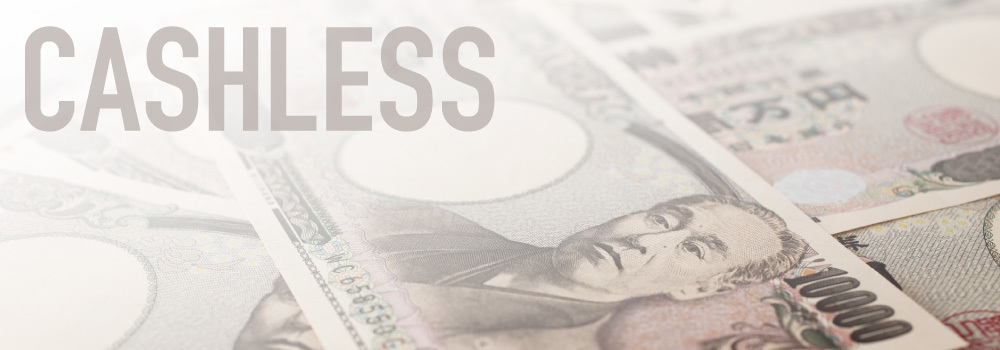
Slow Adoption of Cashless Payments Among Small and Medium-Sized Stores

Source: Dentsu Inc. Cashless Project "Survey on Cashless Awareness Among Consumers During the COVID-19 Pandemic: Small and Medium-Sized Stores Edition, December 2021" [Sample Size: 600]
This survey revealed barriers to promoting cashless payments even among small and medium-sized stores. The chart above shows the results of a survey on cashless payment adoption among 600 small and medium-sized stores (250 retail, 350 food service). Only 52.3% of these stores had adopted cashless payments.
The breakdown shows 39.4% had adopted cashless payments before October 2019. 12.9% adopted after October 2019, following the Japanese government's cashless campaign. Of this 12.9%, only 5.8% adopted cashless payments after the state of emergency declaration in April 2020.
These results indicate that while the government's 2019 cashless campaign was effective, subsequent progress has been limited. This means 47.7% of small and medium-sized stores still do not accept cashless payments. Breaking it down further, 44.0% of retail businesses and 50.0% of food and beverage establishments have yet to adopt cashless systems.
Next, we asked SMEs that had adopted cashless systems about their benefits. The most common response was "Reduced hassle of preparing change" (26.7%). This was followed by "Expanded customer base" (19.4%) and "Shortened checkout time" (19.0%).
Despite these effective benefits—improved productivity/cost reduction and increased sales—roughly half of stores hesitate to adopt cashless payment. Where exactly is this barrier?
Small and medium-sized stores' concern is improving cash flow
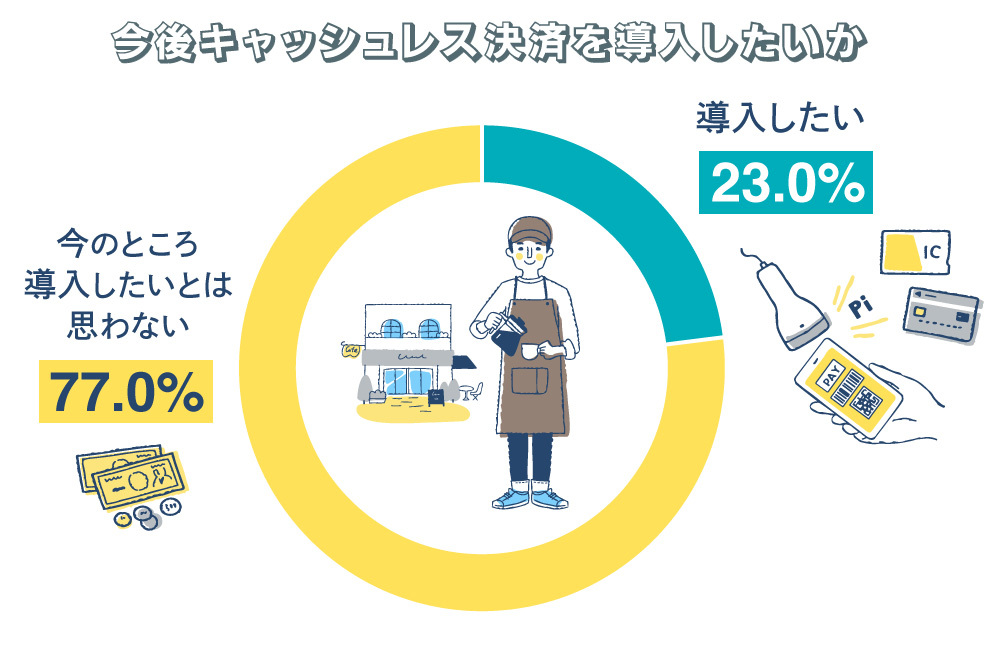
Source: Dentsu Inc. Cashless Project "Cashless Awareness Survey Among Consumers During the COVID-19 Pandemic: Small and Medium-Sized Stores Edition, December 2021" [Sample Size: 286]
So, what about the adoption intentions of small and medium-sized stores that haven't implemented cashless payments? The survey found that only 23.0% of non-adopting stores expressed an intention to introduce cashless payments. Unfortunately for those promoting cashless adoption, 77.0% have no intention of introducing it.
When asked what would need to be resolved for them to take the plunge, 60.7% cited lower (or free) merchant fees. Next, 37.1% mentioned lower (or free) initial investment costs for terminals and systems.
So, is eliminating fees and initial costs the only way to break down barriers to cashless adoption? To find clues, we asked small and medium-sized stores that have already adopted cashless payments what they expect from payment service providers. This revealed that this approach alone may not be the solution.
The top expectation for payment service providers was "early payment of sales proceeds," cited by 46.6% of respondents. This response rate was more than double that of other answers. This result clearly shows that the daily cash flow is a major concern for small and medium-sized stores. Even if fees and initial setup costs aren't free, the key to cashless penetration may lie in highlighting benefits that address the specific concerns of these stores.
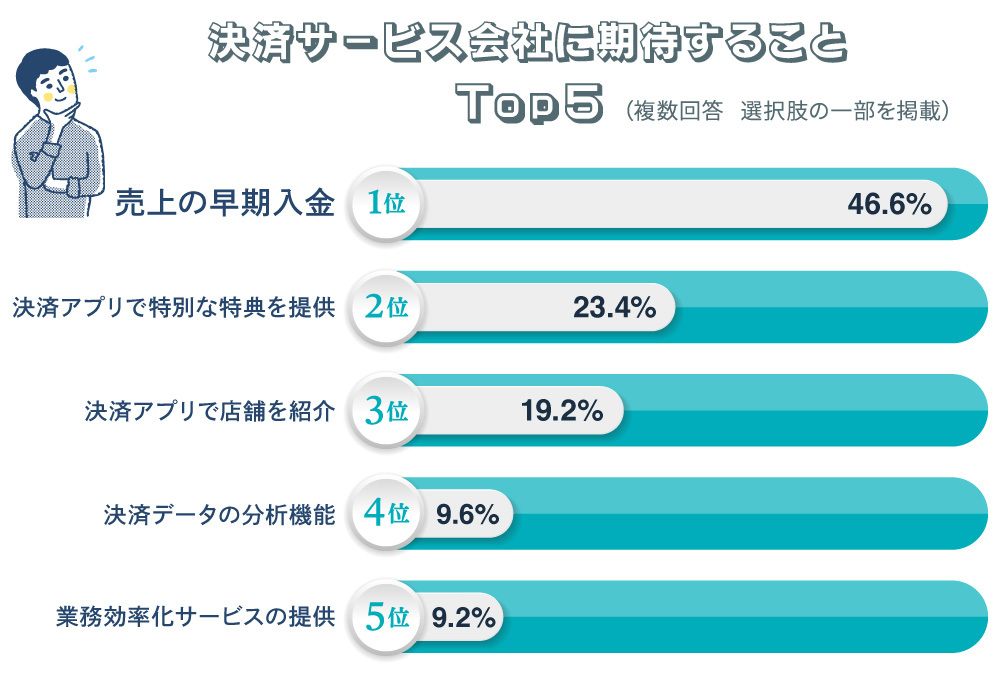
Source: Dentsu Inc. Cashless Project
"Cashless Awareness Survey Among Consumers During the Pandemic: Small and Medium-Sized Stores Edition, December 2021" [MA Sample Size: 314]
Even with cashless adoption, the proportion of cash payments remains high
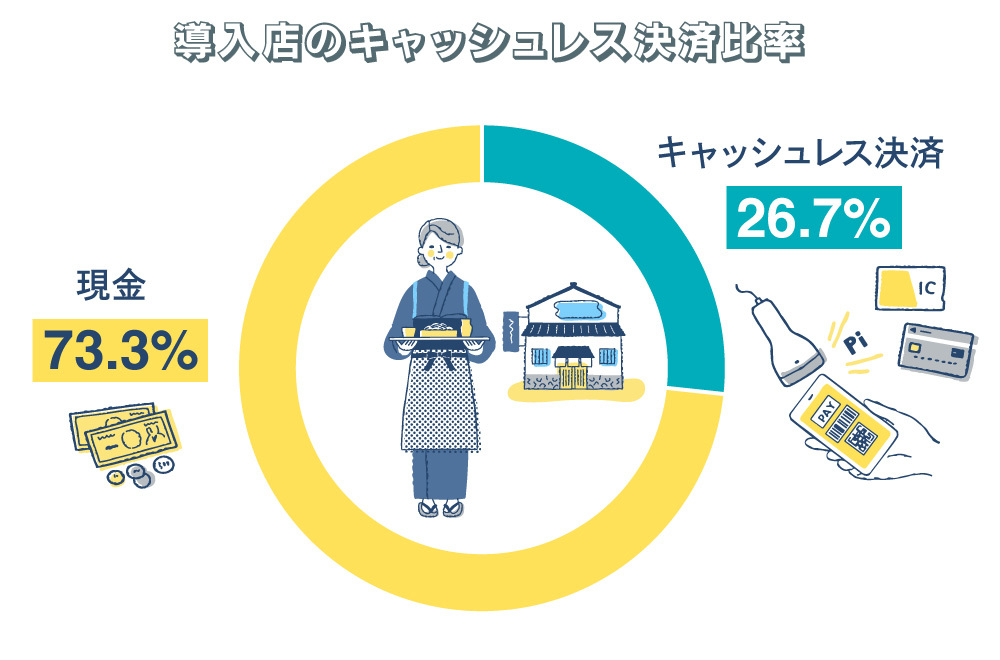
Source: Dentsu Inc. Cashless Project "Survey on Cashless Awareness Among Consumers During the COVID-19 Pandemic: Small and Medium-Sized Stores Edition, December 2021" [Sample Size: 314]
What percentage of sales at stores offering cashless payments actually comes from cashless transactions? In this survey, we asked: "At your store, what is the ratio of 'cashless payments' to 'cash payments' as payment methods for customers? Please provide the ratio based on amount for each."
The results showed that the average ratio of cashless payments was 26.7%. Even among stores that have adopted cashless payments, the cash payment ratio remains high at 73.3%. This suggests that, in reality, cash payments account for three-quarters of total sales at these stores.
As mentioned in the first article, this survey also revealed that even consumers who possess cashless payment methods still use cash frequently. Among small and medium-sized stores, 63.6% of consumers use cash; for restaurants, it's 63.1%; and for shopping districts, it's 59.3%. While cards and mobile payments are also used, cash usage remains high at around 60%.
Amidst this, the top reason small and medium-sized stores adopted cashless payments was "to improve customer convenience" (59.1%). This was followed by "customer requests" (40.6%). While small and medium-sized stores introduced cashless options to meet customer needs, the data clearly shows cash payments still dominate. To further establish and spread cashless payments , there may still be work to be done, such as stores actively encouraging customers to use cashless methods.
Why does cashless payment take longer to complete than cash?
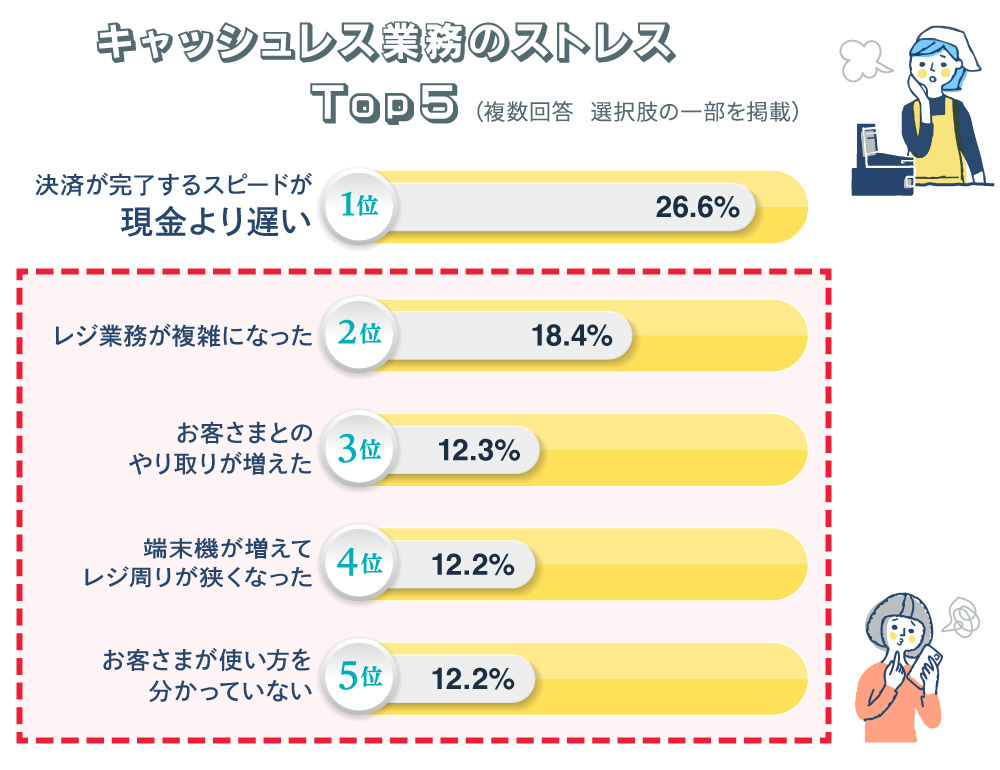
Source: Dentsu Inc. Cashless Project "Survey on Cashless Awareness Among Consumers During the COVID-19 Pandemic: Small and Medium-Sized Stores Edition, December 2021" [MA Sample Size: 314]
One reason cash still accounts for three-quarters of transactions at stores offering cashless options may be operational challenges. Based on this hypothesis, we asked about the operational stress felt when cashless payments increase.
The most common response was "Payment completion is slower than with cash" (26.6%). For the project members, this result was one of the main surprises in this survey.
Fundamentally, the value proposition of cashless payments is often described as "frictionless" (meaning less friction or resistance in the customer experience). Cashless payments were understood to have made transactions smoother and faster by eliminating friction and resistance in the payment process. Yet, here we find that cashless payments are perceived as slower than cash.
Looking at other responses, the reasons likely lie in the answers that followed in second place and beyond. Specifically, responses like "Cashier operations became more complex" (18.4%), "Customer interactions increased" (12.3%), "More terminals made the register area cramped" (12.2%), and "Customers didn't know how to use it" (12.2%) suggest these factors might be why "the speed of completing payments is slower than cash."
The store's issues likely lie in the complexity of operations and the time it takes for employees to become accustomed to handling cashless payments. On the other hand, consumers also face situations where they are unfamiliar with how to use cashless payments or find them more troublesome. This results in increased interactions. This may be an issue that stores and payment service providers should work together to resolve.
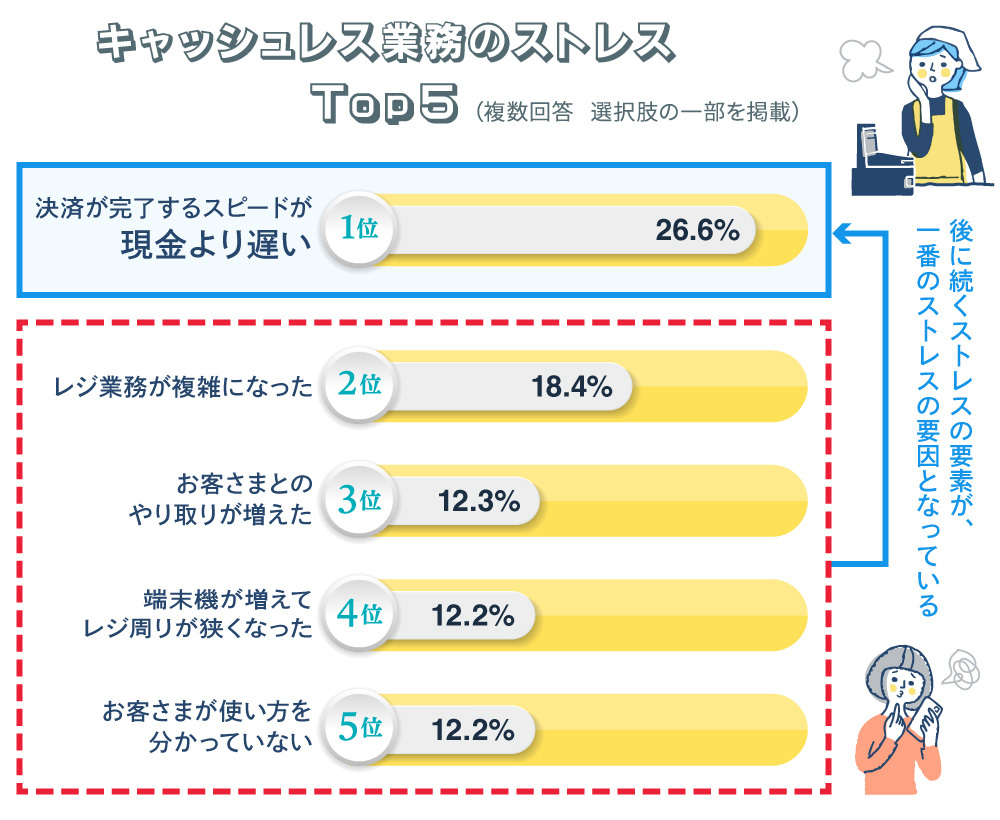
Source: Dentsu Inc. Cashless Project
"Survey on Cashless Awareness Among Consumers During the COVID-19 Pandemic: Small and Medium-Sized Stores Edition, December 2021" [MA Sample Size: 314]
Essential to cashless adoption in small and medium-sized stores is the enhancement of digital services that meet their needs.

Source: Dentsu Inc. Cashless Project "Survey on Cashless Awareness Among Consumers During the COVID-19 Pandemic: Small and Medium-Sized Stores Edition, December 2021" [SA Sample Size: 200].
Late last year, some major mobile QR payment providers raised merchant fees that had previously been free. If the fees for the mobile QR payment system a store uses were to increase, how would the stores that adopted it react?
The survey included 200 small and medium-sized stores using mobile QR payments. This represents about one-third of all small and medium-sized stores that responded to the survey. Mobile QR payments truly took off around 2018. In just three years, one in three small and medium-sized stores has adopted them. The fact that both initial setup costs and merchant fees were free was undoubtedly a major driver of this rapid adoption.
When asked how these 200 stores would respond to the price increase, 89.1% stated they "wish to continue using the service," while only 9.9% said they "wish to cancel" and a mere 1.0% had "already canceled." This result suggests that merchant fees are not necessarily a barrier to the adoption of cashless payments among small and medium-sized stores.
Looking at the chart on "Expectations for Payment Service Providers" mentioned earlier, small and medium-sized stores expect: "Special benefits offered through payment apps" (23.4%), "Store introductions via payment apps" (19.2%), "Payment data analysis functions" (9.6%), and "Provision of business efficiency services" (9.2%).
Mobile QR payment providers already offer some of these services. Even if fees increase, stores that have already adopted these services indicate they "want to continue using them" if these needs are met.
Moving forward, as we advance cashless adoption among small and medium-sized stores, it will become increasingly important to quickly identify and incorporate these digital service needs—driven by cashless payments—into our offerings.
[Survey Overview]
Title: 2nd Survey on Cashless Awareness Among Consumers During the COVID-19 Pandemic
Survey Method: Internet survey
Survey Period: December 16-17, 2021
Survey Area: Nationwide
Survey Participants: 500 men and women aged 20–69 (weighted based on population composition)
Survey Sponsor: Dentsu Inc., Dentsu Cashless Project
Survey Company: Dentsu Macromill Insight, Inc.














